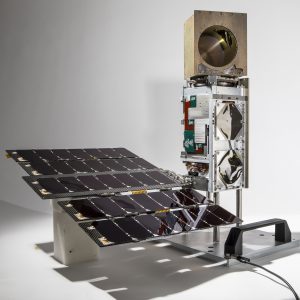Ring Rocks
From about a degree above the unilluminated side of Saturn's ringplane, the Cassini spacecraft spies two of the small moons that skirt the edges of the planet's rings.
Atlas (32 kilometers, or 20 miles across) is seen at center right between the A and F rings. Epimetheus (116 kilometers, or 72 miles across) appears exterior to the F ring, above center right.
The group of little, irregularly shaped, icy bodies that hug the rings -- so much smaller than the great icy moons like Tethys, Enceladus, etc. -- is sometimes referred to as the "ring rocks."
The image was taken with the Cassini spacecraft narrow-angle camera on Jan. 17, 2008 using a spectral filter sensitive to wavelengths of infrared light centered at 930 nanometers. The view was acquired at a distance of approximately 1.3 million kilometers (800,000 miles) from Epimetheus and 1.2 million kilometers (760,000 miles) from Atlas. Image scale is 8 kilometers (5 miles) per pixel on Epimetheus and 7 kilometers (4 miles) on Atlas.
The Cassini-Huygens mission is a cooperative project of NASA, the European Space Agency and the Italian Space Agency. The Jet Propulsion Laboratory, a division of the California Institute of Technology in Pasadena, manages the mission for NASA's Science Mission Directorate, Washington, D.C. The Cassini orbiter and its two onboard cameras were designed, developed and assembled at JPL. The imaging operations center is based at the Space Science Institute in Boulder, Colo.
For more information about the Cassini-Huygens mission visit http://saturn.jpl.nasa.gov . The Cassini imaging team homepage is at http://ciclops.org .
Credit: NASA/JPL/Space Science Institute






















-Carolyn_Y._Ng.jpeg?w=1024)





